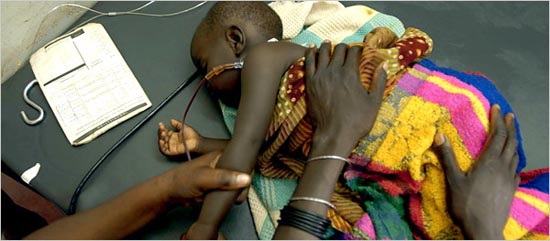New breakthrough in malaria treatment
Canadian researchers have found a way to industrially produce artemisinin, the main component of the most effective antimalarial drugs available today.
Artemisinin is a chemical extracted from wormwood, grown in parts of Asia and Africa. However, the cultivation and harvesting of this plant, then the artemisinin extract takes a lot of time and labor.
Moreover, the supply of this natural compound also depends on the weather and planting conditions.
Patrick Covello, author of the study, said they identified four genes that produce the protein that leads to artemisinin.

A malaria patient in Senegal.Photo: Nytimes
Meanwhile, researchers at the University of California (USA) have discovered the " precursor " of artemisinin by introducing this chemical into yeast. After the two genes discovered by Canadian researchers were added to the yeast mixture, they produced semi-artificial artemisinin.
This new finding could help provide developing countries with anti-malarial drugs with low prices and a stable supply because this fermentation process is shorter and more reliable than growing wormwood.
Sanofi-aventis said it was preparing to produce anti-malarial drugs, using the gene discovered in Saskatoon, on a commercial scale since 2012.
The Canadian government spent 869 thousand Canadian dollars on the study under a commitment to improving the health of women and children in developing countries. Research results are seen as a breakthrough in the treatment of malaria, as well as in the fight against this disease globally.
- Australia: A breakthrough discovery brings hope to cure malaria
- A breakthrough in preparing malaria vaccines
- The first vaccine against malaria loses its effectiveness after 4 years of injection
- The trial of malaria vaccine achieved positive results
- New way to kill malaria parasites
- How to diagnose, treat and prevent malaria
- Treating malaria a single dose
- Tools for detecting fake malaria
- 'Aggressive' drug-resistant malaria parasites spread throughout Southeast Asia
- Discover how to kill malaria-causing parasites
- Viagra helps fight malaria
- Southeast Asia is afraid of drug-resistant malaria
 Green tea cleans teeth better than mouthwash?
Green tea cleans teeth better than mouthwash? Death kiss: This is why you should not let anyone kiss your baby's lips
Death kiss: This is why you should not let anyone kiss your baby's lips What is salmonellosis?
What is salmonellosis? Caution should be exercised when using aloe vera through eating and drinking
Caution should be exercised when using aloe vera through eating and drinking